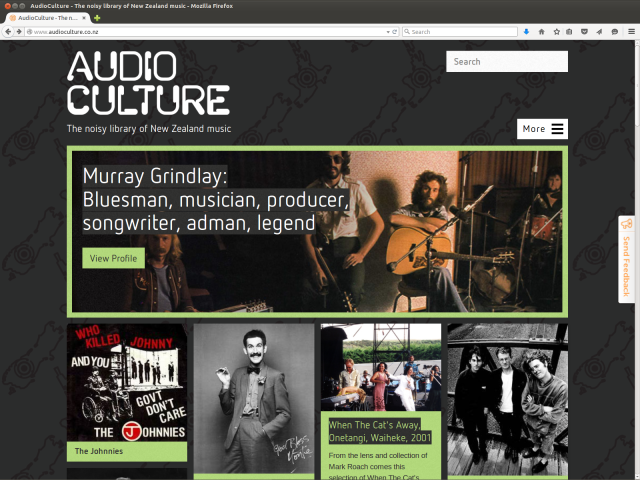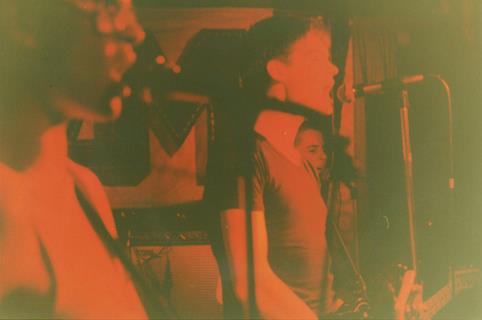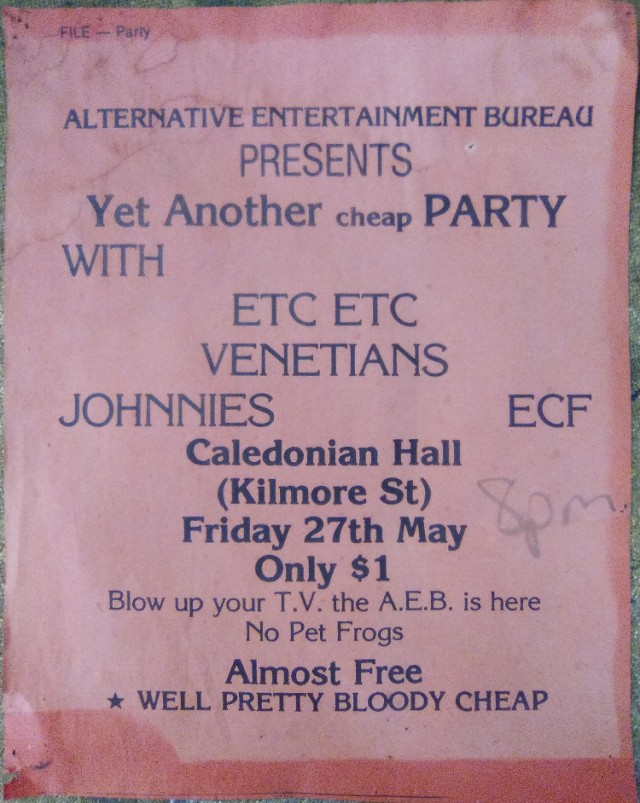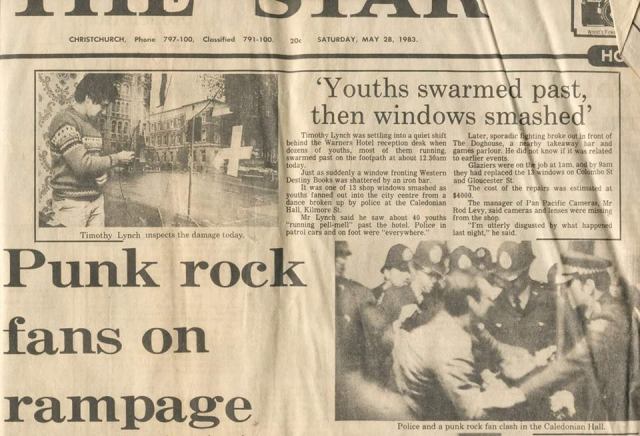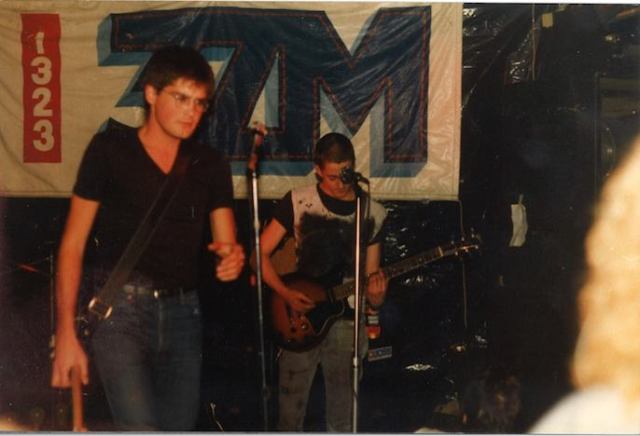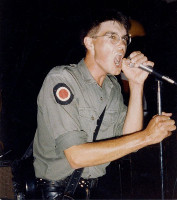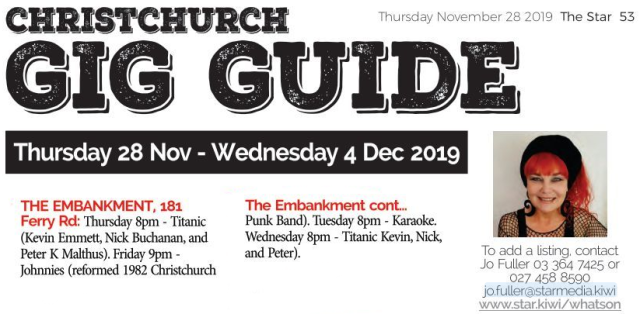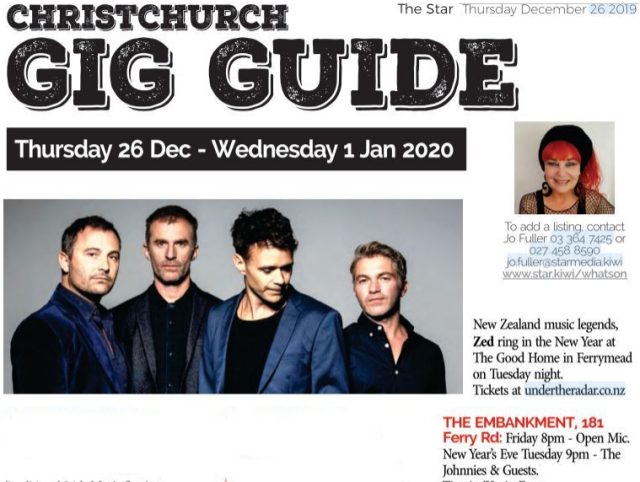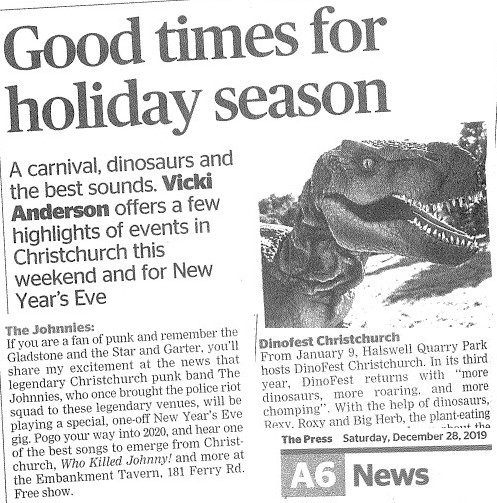Last week’s Audio Culture profile brings back memories, and myths that can now be dispelled, thanks to the internet. For the benefit of supporters of The Johnnies, and of posterity, here is more information from one who was there, re: http://www.audioculture.co.nz/people/the-johnnies
From the top; yes Jolly-Ups spawned The Johnnies, and were a ska group with ‘Rudy’ Bruce Curtis as their laugh-a-minute singer who prided himself on wearing “dead men’s suits” from second-hand stores; when he was dressed! They were great fun. Bass player Mike Smith and Rudy had been work colleagues of mine so when the time became right I joined their music progression. Mike had Neil McRobie as drummer, making a solid rhythm section, then found keen guitarist Vince Haughey. Yes, every punk was at the Gladstone pub venue those days, including Vince. That The Johnnies were never invited to play the Gladstone seemed unfair, especially to Vince.
After the Jolly-Ups had (played the Gladstone and) folded, so had my first full band, so by completing Vince’s three chord thrash, The Johnnies got us all going anew – after 1981, a dramatic year in NZ-UK. My role was lead vocals and sometimes second rhythm / feature guitar. We all wrote most of the songs together, and me most of the original lyrics. I wasn’t new at it, which was why I was asked to join.
From Mairehau High, 1978 was the last and schoolboys The Plague practise year, writing and learning songs and a set at a hired church hall in Burwood with my brother Chris and friends. This we got kicked out of for loud obscenity / being too punk. Fair enough! Better things awaited. Leaving school and home, our Gloucester Street, Linwood flat (just down the road from Paul Kean and Jane Walker of Toy Love) became base for Plastic Impact and entry to the Christchurch pub entertainment scene. All having jobs, we could buy equipment and beer. This punk, new wave-looking band went well and did many gigs at local halls and pubs over the next two and a half years, and had a good following. We upheld “The Plague” anthem, more original works, and some Ramones, Pistols, Wire, Buzzcocks, Voidoids, etc covers that people loved dancing to.
Impact terminated to saddened calls of “Don’t break up!” at the Arts Centre one Saturday night mid-1981, still gaining audience but setting everyone free with the same earnings share. I had been lead singer and manager. Chris (later Anzak) took a new course with The Solatudes (pre-Wastrels) sharp, tuneful rock, moving from guitar to bass, influenced by glam (also Doors, Beatles). I started learning guitar, and practised with The Orggies three-piece from the Impact circle, still on vocals doing basic all-original work. We played the Gladstone once, and nowhere else I can recall. No legacy remains of that short period (until now).
But the core punk ethos was still gaining strength, against new wave trend, and so the Johnnies formed. From punk transition came division, nee joy. This was very much an echo of 1981, characterised by civil protest stopping a Springbok rugby tour, Brixton Riots, Muldoon-Reagan-Thatcher rule, miners’ strikes, South American invasions and Falklands war. Counter-politics had voice and platform in punk. As did regular partying.
A practise room was rented, above Peaches and Cream on St Asaph/Colombo Street corner, and used diligently. Mike, Rudy and I were all students before long, and eventually shared a flat with other friends in Peverell Street, Riccarton, which was very enjoyable.
But a sexist line in the signature song “Who killed Johnny?” was required of whoever would sing for this band. As artistic portrayal of a warmly memorialised character, I chose to show willing to air it. Changing ideas is neither easy nor quick.
The Johnnies’ first performance opportunity came through a social connection of the new band, and this was to mark it permanently. A Sunday afternoon backyard drinking session hosted us, a private party at the home of casual white supremacists, for maybe a gang. The boot cause took a shine to us instantly and attended almost every Johnnies gig to come. From this notoriety grew. We never fed it consciously – listen to the recording – and this occasion would be the only negative fact about The Johnnies to unearth, for what it’s worth.
None of The Johnnies had a skinhead punk persona. But many of our audience did. Confrontations with police happened where we played, with an incident outside Caledonian Hall making a newspaper headline. So controversy began and festered.
This was the band’s first public appearance, around the height of the skinhead punk phase, when a minority were diverting Oi into nazi-punk. This drift necessitated the term neo-punk, or abandonment of punk altogether by some adherents, over time. There was an atmosphere of typical youth rebellion, with politics non-specific; that was most of the ‘skins’ – generally exuberant, harmless rockers, going through a youth phase. A few more gigs were found, with better detail listed by Audio Culture than I can write. A Horticultural Hall performance maybe too? A minority of times there were problems, but when there were they stuck.
The lowlight eclipsed a high for The Johnnies, at a Battle of the Bands mid-winter in the Star and Garter hotel, 1982. Playing last, we powered through a blistering set. The dance floor was packed and pumping, demanding more, perhaps the biggest crowd we ever engaged with. We had run out of songs. This one-and-only encore ever required of The Johnnies could only be “Who killed Johnny?” played again. Happy punters! Then to the judges. Moderate calm anticipation; but they had already left and given the decision to the previous act, Ballon D’Essai – newly-formed, quieter, more sharply composed post-punk, new wave. Much less of a dance band that day. Jordan Luck was there. The judges must have picked technical skill / musicianship over sheer momentum. It felt like injustice to most people there. The place spontaneously erupted. Boot girl and boy rage let rip on the hotel doors, lower walls and maybe washroom porcelain; other pub gang presence got involved too, apparently. The venue was vacated pretty promptly, before authorities arrived. The Johnnies could rarely get bookings to play after that.
Skin gig violence spelt a definite end to punk-era fun, and peaked the following year, as documented around Evasive Action. It was atypical of original punk mind-expansion and drove most far away from it.
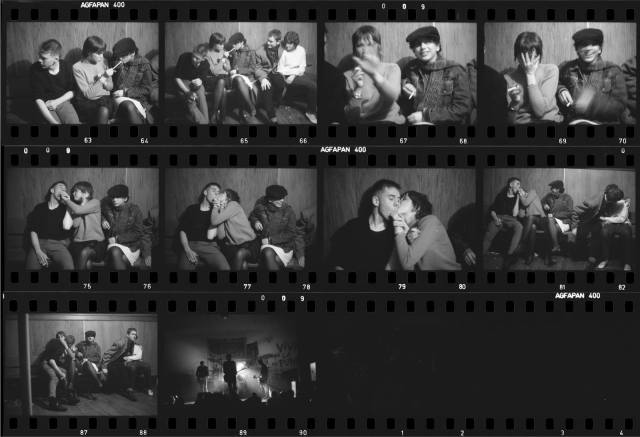
Caledonian Hall audience at a typical gig – Evasive Action c1983 – pic David Cook exhibition book
Differences and minor scraps may have put The Johnnies off any prospect of touring together, but mostly we all had jobs or studies that we were committed to. This was a disciplined, professional outfit, in enough ways, if somewhat oxygen-deprived. The shining exception was an Otago foray, to play upstairs at a small pub with the PD Boys, who were good company. I’m unsure where they came from – Ashburton? – or what happened for them next. The PD Boys and The Johnnies contrasted the national pop “Dunedin sound” taking hold through that time, so no ovations there. A good after-party though.
Speaking of PD, The Johnnies’ only run-in with the law was some being stopped in our friend’s car, by the Hereford Street police after placing a poster on their station wall. How very unjust! 😉 lol
Guitar with social commentary sounds parallel to The Johnnies were Gang of Four and Killing Joke – far from Oi bands. We existed near the boundary of Oi, as did every punk band in early-80s Christchurch, of which there were several. Oi fought weakly for the heart of all these music groups and got nowhere as far as I know. It wasn’t like England, where football support tours got taken over for pitched battles around this time. In New Zealand we are typically liberal-left, always improving our embrace of cultural diversity; so too in Christchurch predominantly. If an individual chose to pitch The Johnnies to an Oi audience, in an Oi way as the archived PJ’s gig poster indicates, that was beyond democratic decision of the band and of arguable significance: a misguided and isolated expression of graphic free speech. We were in it for the music, enjoyment and an appreciated profile, at the end of the day. Marketing is very difficult to monopolise and image even harder to control.
Bands most closely related to The Johnnies were Unauthorised and Desperate Measures. Of course The Androidss broke ground for us all and had just played out. Ballon D’Essai surprised at the Gladstone.
Although we’d all get on fine now, at the time young musicians can be egotistical and very competitive. Fault-finding is qualification for ‘cool’ discrimination. In that light came The Star interview and slanted comment that Andrew Schmidt repeats for Audio Culture. My non-appearance at the cited interview was by accident, not intention, contempt or having “nothing to say”. Quite the opposite. A lot of band organising had fallen to me, then a full-time student, including studio booking, manufacture, distribution and publicity for The Johnnies’ EP. Without gigs we needed some kind of outlet! The Wellington trip to EMI record-press enabled the Chelsea Records drop from which Schmidt’s disc purchase became possible. So it was a case of – as one wouldn’t expect – forgetting a last, most important action: the Star media interview appointment. I had set all the guys up to go, after which the date slipped my own mind as lead organiser attending lectures. Unfortunately mistakes happen. This made The Johnnies look unaccountable and maybe worse.
Punk had extreme innovation and energy – it could find any direction, and did. What happened with The Johnnies was a bit like the Sex Pistols, when Glen Matlock (who brandished a picture of Karl Marx on his bass) was replaced by Sid Vicious (who could barely play). These people were many of our generation’s heroes, our inspiration, and Sid’s fate was symptomatic of steady degradation of wit, tone and point, getting ‘out of it’ on the substances of rock ‘n’ roll lifestyle, and dilution of all-important social critique into awful consumerism. Branded.
The final Johnnies gig was probably its best though, at the University of Canterbury Students’ Association upstairs bar, late January 1984. Our sound was really tight, powerfully motivating and on the edge. People thrilled to hear it, most often for a single time, and met it with their feet. Then their hearts and minds? The Johnnies had gained tuuturu punk mystique through struggle to exist, and a smooth routine on instruments; a story ending well.
This was a farewell party performance, for my brother’s next new band and my own, and all our friends, as we two were UK-bound. Leaving Christchurch and music behind, for a very long time, was a sure way of resolving the tension between Johnnies popularity and frustration. I sold my black Telecaster and Rockit amplifier so there could be no turning back. Politics was better pursued without a soundtrack, I was learning (like Peter Garrett).
Caption to close: A Christchurch punk post-Chile-Panama-Falklands anti-militarist caricature act exits stage left.
Postscript: Both The Gladstone and the Star and Garter got pulled down, before and after the Canterbury earthquakes, and are fondly remembered by very many musicians and audiences. Excellent days and nights! Thank you everyone who played a positive part. Kia ora.
Ref. http://www.failsaferecords.com/history/intro.htm
https://www.popsike.com/php/quicksearch.php?searchtext=The+Johnnies finds:
THE-JOHNNIES-WHO-KILLED-JOHNNY-RARE-NEW-ZEALAND-PUNK-7/380732838066.html
THE-JOHNNIES-Rare-New-Zealand-Punk-Band-EP-1981/261406652587.html
The-Johnnies-Who-killed-Johnnie-7-1982-KBD-Punk-MDC/4870252999.html
Copyright – Rik Tindall 2015-2020 – please contact me if you wish to republish.
[Page under development – more text/pix to follow – do return later]
Since this article, The Johnnies reunion eventually began – at The Club Tavern in Sydenham over some beers – mid-January 2019. The guys geared up through the year, practised quite regularly (except for a winter lull) and performed 3 gigs: drummer Neil’s birthday party (with The Androidss) at The Black Horse Tavern in Middleton early May, then at The Embankment Tavern in Philipstown 29 Nov, on to 31 Dec: a first ever headline billing, with new print media coverage..
.
.
.
.
.
.
.
.
.
.
.
.
.
.
.
.
.
.
.
.
.
.
.
Video recordings were made each time in 2019, atop new social media channels:
https://www.youtube.com/channel/UCU27U-pQW-xEP6mHPuFwIww
https://www.youtube.com/channel/UCMu_Hvh7y2tMJyZfhx36dhw
https://www.facebook.com/TheJohnniesNZ
City background:
Aotearoa Punk Timeline 1976-81 & A Flying Nun pre-history audioculture.co.nz
Christchurch in the 80’s [By David Swift] thebigcity.co.nz
The Pin Group: Complete Interview with Roy Montgomery thebigcity.co.nz
You could say there was a class divide, around the artsy aesthete stories here deriding second-wave punk part-covers bands who – succeeding The Doomed big influence – filled an important niche providing high-energy sounds that the masses of newcomers knew and could dance to, making these significantly popular alongside good all-original bands.
Decomposed: The Political Ecology of Music The hidden material histories of music, Kyle Devine, The MIT Press, Oct 2019 + Nightmares on wax: the environmental impact of the vinyl revival The Guardian, 28 Jan 2020. Songwriting with Charlotte Yates RNZ, 28 Jan 2020.

